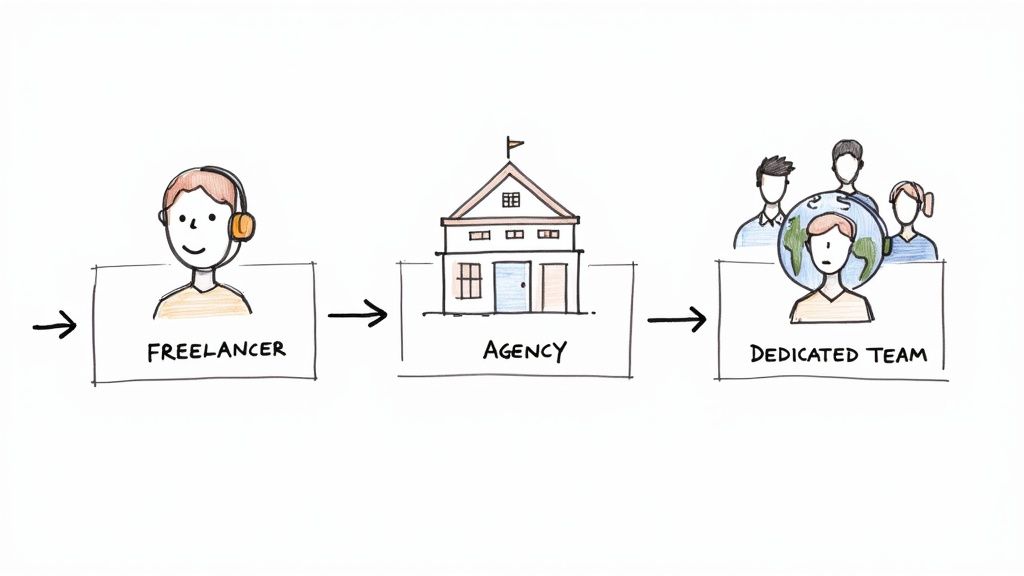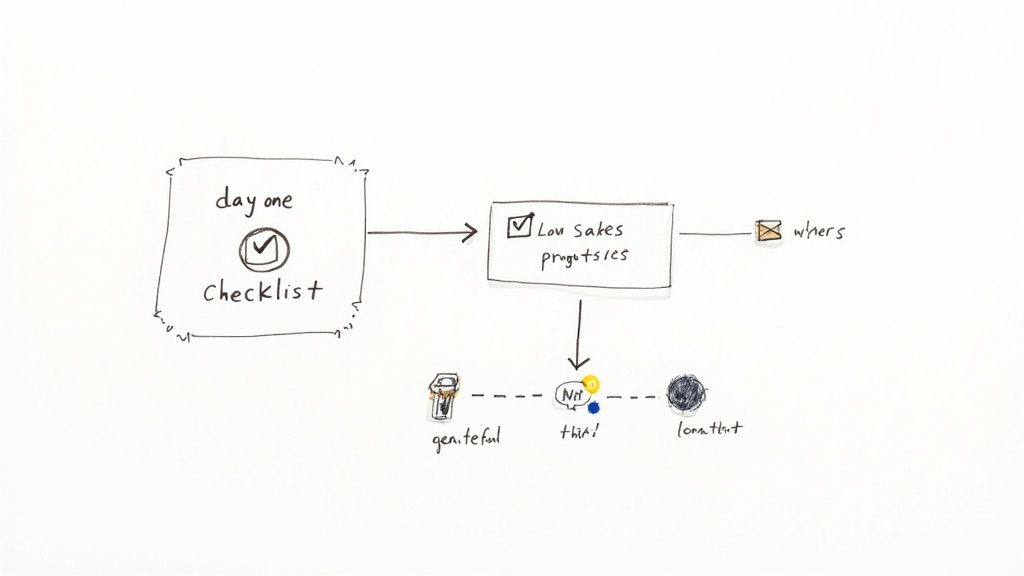Discover hire remote development team: The Smart Way

Before you even think about hiring a remote development team, you need a rock-solid plan. This isn't just a suggestion; it's the most critical step you'll take. Laying this groundwork—covering your project's scope, tech needs, budget, and success metrics—is what separates successful projects from those that spiral out of control.
Defining Your Project Before You Hire

Jumping into hiring with a half-baked idea is a recipe for disaster. You can't find the right developers if you don't know exactly what you're building. It’s about moving beyond a vague concept and creating a detailed project scope that a potential hire can actually sink their teeth into.
This initial planning isn't just about making a feature list; it's about drawing a clear map for everyone to follow. With about 28% of employees worldwide working remotely in 2023, clear, documented plans are more important than ever for keeping distributed teams on the same page.
From Vague Idea to Concrete Scope
First things first: write down the core problem your project solves and who it solves it for. Who is your end-user? What specific pain are you eliminating? Getting these answers straight crystallizes your vision and guides every decision that follows.
Next, break the project down into its core components. I find it helpful to think in terms of user stories or key functions. For example, instead of saying "build an e-commerce site," get specific: "A user must be able to create an account, browse products by category, add items to a cart, and complete a secure checkout with a credit card."
Key Takeaway: A detailed scope is your North Star. It keeps scope creep at bay, gets all stakeholders aligned, and gives potential hires a real sense of the work involved. This means you'll get much more accurate cost and time estimates right from the start.
If you want to go deeper on this, our guide on how to define project scope walks you through the nitty-gritty.
Must-Haves vs. Nice-to-Haves
One of the most common traps I see people fall into is creating a massive wish list of features. This doesn't just blow up your budget; it makes finding a team with the perfect skillset nearly impossible. You have to be ruthless in categorizing your requirements.
Create two simple lists:
- Must-Haves: These are the absolute, non-negotiable features. Without them, your product doesn't solve the core problem. For a ride-sharing app, this would be things like GPS tracking, a driver-rider matching algorithm, and in-app payments.
- Nice-to-Haves: These features would be great additions but aren't critical for your first launch. Think of things like a loyalty program, the ability to add multiple stops, or a fare-splitting option.
Making this distinction is vital when hiring a remote team because it directly informs the technical skills you're looking for. A "must-have" list focused on core functionality might mean you need a senior backend developer, whereas a "nice-to-have" involving slick UI animations points toward a specialized front-end expert.
Setting a Realistic Budget and KPIs
Your budget has to cover more than just salaries. A truly realistic financial plan also accounts for project management tools, cloud hosting services, subscriptions for third-party APIs, and other administrative overhead. Forgetting these "hidden" costs can stop a project dead in its tracks.
At the same time, you need to define what success actually looks like. Establish clear Key Performance Indicators (KPIs) before a single line of code is written. This ensures you're building something that achieves real business goals, not just a product that's technically functional.
Here are a few examples of solid KPIs:
- User Engagement: Hit 1,000 daily active users within three months of launch.
- Conversion Rate: Achieve a 3% conversion rate on the main call-to-action button.
- Performance: Maintain a page load speed under two seconds for all critical pages.
By setting these benchmarks upfront, you give your future team clear targets. It transforms the project from a simple checklist into a strategic mission, ensuring every decision they make is tied to a measurable business outcome.
Choosing the Right Remote Hiring Model

Alright, you've got your project specs locked down. Now comes the big question: who is going to build this thing? When you hire a remote development team, you're not just picking people; you're picking a whole way of working. This decision will ripple through everything—your budget, your daily schedule, and how much hands-on control you really have.
There are three main paths you can take: hiring freelancers, partnering with an agency, or building a dedicated team. None of them are inherently "better" than the others. The right choice is the one that fits your company's reality—your resources, your long-term vision, and frankly, how much you want to be involved in the day-to-day grind.
The Freelancer Model: Ultimate Flexibility
Hiring independent freelancers is the classic move for startups and companies needing a quick, surgical strike of expertise. Got a three-month project that needs a top-tier mobile UI designer? Or maybe you just need a database wizard to come in and work their magic for a few weeks. This is where freelancers shine.
The big win here is agility. You can spin up a team for a project and then scale back down just as fast, all without the baggage of long-term employment. Plus, you get a direct line to your talent, and they often bring fresh perspectives from working across all sorts of different industries.
But that flexibility comes at a price. Managing a handful of freelancers can sometimes feel like trying to herd cats. You're the one juggling multiple contracts, processing separate invoices, and making sure everyone is on the same page. That administrative work can pile up fast.
The Agency Model: The Hands-Off Approach
Going with a development agency is like ordering the complete, pre-assembled package. You hand over the blueprints, and they take it from there—project management, design, development, QA, the whole nine yards. This is a lifesaver if you don't have a technical lead in-house or you simply want to offload the entire development process.
Agencies have their systems dialed in. They come with a full roster of specialists and a project manager who becomes your single point of contact. Their reputation is on the line, so you can generally expect a certain level of quality and professionalism.
The trade-offs? Cost and control. Agencies charge a premium for their all-in-one service, and you usually don’t get to pick the specific developers working on your project. That layer of separation can sometimes lead to communication lags or a feeling that your project is just another ticket in their system.
The Dedicated Team Model: A True Extension of Your Company
A dedicated team, often built with a nearshore or offshore partner, strikes a fantastic balance. Here, a specialized firm helps you recruit and hire full-time developers who work only for you. They’re your team members in every sense that matters, but the partner company handles all the tricky stuff like local HR, payroll, and office logistics.
This model gives you the direct control of an in-house team while tapping into the cost benefits of global talent. You get to interview and select every single person, build a cohesive team culture, and embed them directly into your company's workflow. It’s the perfect play for long-term projects and for companies serious about scaling their development capabilities for the long haul.
Expert Insight: Building a dedicated team is more than just a hiring strategy; it's an investment in your company's intellectual property. You're not just buying lines of code for a single project. You're cultivating a loyal team that understands your product inside and out and grows right alongside your business.
This is fundamentally different from old-school outsourcing, where you just toss work over the fence. With a dedicated team, you are in the driver's seat. For a deeper dive into how this compares to other models, understanding the nuances of staff augmentation vs outsourcing can provide further clarity.
To make this choice a little easier, let's lay it all out.
Comparing Remote Hiring Models: Freelancers vs Agencies vs Dedicated Teams
This table breaks down the three main remote hiring models across the criteria that matter most to your business. Use it to see which approach best aligns with your goals for control, cost, and long-term growth.
| Criteria | Independent Freelancers | Development Agency | Dedicated Team (Nearshore/Offshore) |
|---|---|---|---|
| Control | High (direct management) | Low (managed by agency PM) | High (direct management) |
| Cost | Variable (hourly/project) | High (premium for managed services) | Moderate (lower salaries, partner fee) |
| Scalability | High for short-term needs | Moderate (depends on agency capacity) | High for long-term growth |
| Admin Overhead | High (contracts, payments, vetting) | Low (handled by agency) | Low (handled by partner) |
| Integration | Low (task-based) | Low (external team) | High (extension of your company) |
Ultimately, this is a strategic call. If you need a specific skill for a short sprint, freelancers are your answer. If you want a finished product with minimal management from your side, an agency is the way to go. But if your goal is to build a sustainable, integrated, and cost-effective development engine for the future, a dedicated remote team is tough to beat.
How to Source and Vet Top Remote Talent

Alright, you've decided on your hiring model. Now for the fun part: the actual hunt. Finding and validating the right developers is as much an art as it is a science. You're not just looking for someone who can code; you need to find people who think critically, communicate clearly, and thrive from a distance.
Let's be real, the demand for skilled developers is through the roof. You're swimming in a global talent pool, which is both a blessing and a challenge. Projections show the worldwide developer count hitting around 20.8 million by 2025, with a huge chunk of them already working remotely. This massive pool means your ideal candidate is out there, but you'll need a sharp strategy to find them.
Sourcing Talent Beyond the Obvious
The best developers I've ever hired weren't found on the giant, faceless job boards. They're usually busy building, learning, and sharing their craft in niche communities. If you want a top-tier remote team, you've got to meet them where they live.
- Go to the Watering Holes: Think places like Stack Overflow, Dev.to, and specific Slack or Discord channels dedicated to languages like Python or Go. These aren't just places to post a job; they're where you can see developers solving problems and interacting with peers in real-time.
- Let GitHub Tell the Story: A developer’s GitHub profile is more revealing than any resume. Check out their contributions to open-source projects. It’s a direct window into their initiative, collaborative spirit, and genuine passion for their work outside of a typical 9-to-5.
- Use Specialized Platforms: Skip the generalist sites. Platforms that are built specifically for remote tech talent often have a pre-vetted pool of candidates, which can save you a ton of time on initial screening.
The key here is to engage, not just advertise. Participate in discussions and offer value before you ask for anything. This positions you as an employer who gets it, not just another company with a vacancy to fill.
Designing a Vetting Process That Actually Works
Once you've got a shortlist of promising candidates, your vetting process is everything. A weak process lets the wrong people through and scares away the great ones. Your goal should be to simulate the real work environment as closely and respectfully as possible.
The technical assessment is your first major filter. Forget abstract brain teasers—they're a terrible predictor of on-the-job performance. Instead, create a practical challenge that mirrors a task they'd actually do for you. To really dial this in, you can explore various technical skills assessment methodologies that focus on real-world application.
For instance, if you're hiring a front-end developer, give them a Figma file and ask them to build a responsive component. For a back-end role, have them create a simple API endpoint based on a clear set of requirements. This approach shows you how they structure their code, document their process, and solve problems under realistic conditions. For a more detailed walkthrough, our guide on https://getnerdify.com/blog/how-to-hire-software-engineers offers some great, practical tips.
Assessing Soft Skills for a Remote World
Technical skill is only half the battle. In a remote team, things like communication, self-discipline, and autonomy are what truly separate a good developer from a great one. The behavioral interview is where you dig into these crucial traits.
Don't waste time with questions like, "Are you a good communicator?" Of course, they'll say yes. You need to ask situational questions that force them to draw on past experiences.
Pro Tip: I always lean on the STAR method (Situation, Task, Action, Result) to structure my questions. A favorite of mine is: "Tell me about a time you disagreed with a technical decision from a project lead. How did you approach the conversation, and what was the result?"
This type of questioning gives you concrete examples, not just canned answers. You'll learn about their problem-solving style, how they handle professional conflict, and their approach to asynchronous communication—all absolutely critical for a remote team to succeed.
Navigating Contracts and Legal Complexities
You’ve found the perfect developer. The interviews went great, their portfolio is impressive, and you're ready to get started. It's tempting to jump right in, but this is exactly the moment to pump the brakes and focus on the paperwork.
Hiring someone from another country isn't as simple as a handshake deal. It brings a whole new set of legal and contractual hurdles that can trip you up if you're not careful. Getting the contract right isn't just a box-ticking exercise; it’s the bedrock of a solid professional relationship.
A vague or poorly written agreement is a recipe for disaster. It opens the door to arguments over who owns the code, payment disputes, and compliance problems you never saw coming. A clear, comprehensive contract is your single best tool for making sure everyone is on the same page from the very beginning.
Essential Clauses for Every Remote Contract
Think of your contract as the official rulebook for how you'll work together. It needs to be crystal clear, leaving zero room for interpretation. Ambiguity is your enemy here.
When you hire a remote development team, these are the absolute must-haves in your agreement:
- Intellectual Property (IP) Ownership: This is non-negotiable. The contract must state, without a shadow of a doubt, that every line of code, design, and piece of work created for your project is 100% owned by your company. This is probably the single most important clause for protecting your business.
- Confidentiality and Non-Disclosure (NDA): Your developers will be seeing behind the curtain. An NDA legally obligates them to keep your business plans, proprietary data, and trade secrets under wraps.
- Scope of Work and Deliverables: Get specific. Don't just say, "build the login page." Instead, detail the exact requirements, how you'll define "done" (acceptance criteria), and the deadlines. This is your best defense against scope creep.
- Payment Terms and Schedule: Clearly state the rate (hourly, per-project, etc.), the currency, and the payment schedule. You also need to spell out how they should invoice you and what payment method will be used to avoid any awkward conversations later.
Contractor vs. Employee: What You Need to Know
One of the biggest legal decisions you'll make is whether you're hiring an independent contractor or an employee. Getting this wrong can lead to some pretty serious consequences, like back taxes and hefty fines. The main difference usually comes down to how much control you have over their work.
An independent contractor is their own boss. They set their own hours, use their own tools, and are free to work with other clients. This is the go-to arrangement for most companies hiring developers from another country.
An employee, on the other hand, is much more integrated into your company. They work under your direction, often during set hours, and you're responsible for things like payroll taxes, benefits, and local labor laws—which get incredibly complicated across borders.
Key Insight: Sticking with the contractor model is almost always the simpler path for international hires. Just make sure your working relationship reflects that status. Focus on the results and deliverables in your contract, not on micromanaging their day-to-day process.
Handling International Payments and Compliance
Paying someone on the other side of the world doesn't have to be a headache. There are some fantastic platforms out there designed specifically for this, like Deel or Remote. These services take care of currency conversion, create compliant contracts and invoices, and make sure your developers get paid on time.
When drawing up the contract, it's also a smart move to include a governing law clause. This specifies which country's laws will apply if a dispute ever arises. You’ll probably want it to be your own country’s laws, but this can be a point of negotiation.
Spending a little bit of money to have a lawyer who knows international labor law look over your contract is a small price to pay for peace of mind. It can save you from huge problems down the line.
Onboarding and Managing a High-Performing Remote Team

You’ve navigated the contracts and signed on the dotted line. It’s easy to feel like you’ve crossed the finish line, but really, you're just at the starting gate. The success of your remote development team depends almost entirely on how you bring them into the fold and manage them for the long haul.
A sloppy or nonexistent onboarding process is a recipe for disaster. It leaves new developers feeling disconnected and unsure of their role, which quickly tanks engagement and performance. A thoughtful, structured approach is what sets the stage for a productive partnership from day one.
Building a Bulletproof Onboarding Checklist
That first week is your golden opportunity to make a great impression and set expectations. A solid onboarding plan isn't just about shipping a laptop; it's about systematically connecting your new developer to the team, the tools, and the company's mission. Think of it as their roadmap from being an outsider to a valued team member.
Here’s what a practical onboarding plan should cover:
- Day 1 System Access: Get them immediate access to all essential platforms—code repositories, project management software (like Jira or Trello), and communication channels (Slack or Teams). Nothing kills momentum faster than waiting days for a password reset.
- A "Starter" Project: Assign a small, low-stakes task in their first few days. This could be fixing a minor bug or adding a small, well-documented feature. It lets them get familiar with the codebase and deployment process without the pressure of a major deadline, which is a huge confidence booster.
- Meet and Greets: Schedule short, informal video calls with key people. This isn't just other developers; include the project manager, a designer, and anyone else they'll be working with. Putting faces to names helps build those crucial personal connections right away.
Expert Insight: Remember that onboarding is a two-way street. Use this time to learn about your new hire’s preferred communication style, working hours, and what makes them tick. This mutual understanding prevents a ton of friction down the road and shows you respect them as an individual.
Fostering Communication and Trust
In a remote setup, you can't rely on overhearing conversations or grabbing someone by the coffee machine. Communication has to be deliberate, clear, and consistent. The goal is to create an environment where information flows freely and everyone feels safe enough to ask questions or raise concerns.
The right tools are essential, but it’s how you use them that really matters. Slack is great for quick updates, but critical decisions should be documented in your project management tool or a shared document. Video calls are invaluable for complex discussions, but they should always have a clear agenda to avoid becoming a time-sink.
Building a remote team is also a smart financial move. Research shows businesses can see cost savings of 30-70% by cutting out office-related expenses. Plus, remote work often leads to lower employee turnover, which means less money spent on hiring and training.
Establishing Effective Feedback Loops
Regular, constructive feedback is the lifeblood of a high-performing remote team. Don't wait for an annual review to talk about performance. Instead, create multiple channels for an ongoing dialogue.
- Daily Stand-ups: Keep them brief and focused. A quick async update in a dedicated Slack channel often works better than a forced daily video call that interrupts deep work.
- Weekly One-on-Ones: This is non-negotiable. It’s your dedicated time to discuss progress, remove blockers, and talk about their career goals.
- Code Reviews: Nurture a culture of peer code reviews. This isn't just about catching bugs; it’s a powerful tool for sharing knowledge and maintaining high standards across the entire codebase.
To really build a strong, cohesive culture, you need to go beyond the work itself. This is where engaging virtual team-building activities for remote teams come in. These activities help build the personal bonds that make professional collaboration smoother and more enjoyable. By investing in both the technical and social sides of management, you create a resilient, motivated team that’s ready for anything.
Got Questions About Hiring Remote Developers? We've Got Answers.
Stepping into the world of global talent can feel like a big move. You're making a major strategic decision, so it's only natural to have a few questions swirling around. Let's tackle some of the most common ones we hear from businesses, giving you the straightforward answers you need to feel confident about your next steps.
What's the Real Cost of Hiring a Remote Team?
This is usually the first thing everyone wants to know, and the honest answer is: it really depends. The price tag isn't just a salary; it's a blend of a few key things.
- Where are they? This is the biggest factor by far. A senior developer in San Francisco will have a completely different salary expectation than someone with the exact same skills in Poland or Brazil.
- What can they do? Niche expertise in demanding fields like AI or cybersecurity will always fetch a higher rate, no matter where the developer is based. A team of seasoned senior engineers is also going to be a bigger investment than a group of junior or mid-level talent.
- How are you hiring them? Going through an agency often seems most expensive upfront because they bundle in management and administrative services. Freelancers might look cheaper for a quick task, but a dedicated team model usually strikes the best balance for long-term value.
To give you a ballpark figure, a mid-to-senior level remote engineer will typically fall somewhere in the $10,000 to $20,000 per month range. But remember, this can swing wildly based on their location and specific tech stack.
Should I Go with Freelancers or a Dedicated Team?
This decision really comes down to what you're trying to build and how long you'll be building it.
Freelancers are fantastic for short-term, well-defined tasks. Need a specific feature built or a security audit performed? A freelancer offers that surgical skill without any long-term strings attached. It's all about flexibility.
A dedicated team, on the other hand, is a true investment in your company's core. You go this route when you're developing a product that is central to your business. This model allows a team to build deep, institutional knowledge and a shared culture—something a freelancer juggling multiple clients can never really replicate.
My Two Cents: If you need a quick fix or a temporary skill injection, a freelancer is your best bet. If you're in it for the long haul and want a team that lives and breathes your product, a dedicated team is the way to go.
How on Earth Do We Handle the Time Zone Differences?
This is the phantom menace of remote work—it seems scary, but it’s rarely the showstopper people think it is. The secret isn't to force everyone into a 9-to-5 schedule. It's about being deliberate with your communication.
Most successful remote teams just need a few hours of "overlap time" each day. This is your golden window for any real-time collaboration—think sprint planning, brainstorming sessions, or untangling a tricky problem together.
The rest of the day is for asynchronous work, powered by clear documentation and regular updates in tools like Slack or Jira. This approach actually makes developers more productive by giving them long, uninterrupted stretches for deep, focused work, away from the constant ping of meetings.
How Do I Make Sure the Code Quality and Security Are Top-Notch?
Keeping standards high from thousands of miles away isn't about micromanagement; it's about having solid, non-negotiable processes in place. When you hire a remote development team, you're building a system of trust, but it's the processes that truly guarantee quality.
Here’s what should be standard operating procedure from day one:
- Rigorous Code Reviews: Make peer reviews mandatory before any code gets merged. This is single-handedly the best way to catch bugs, enforce standards, and help the team learn from each other.
- Automated Testing: Your CI/CD pipeline should be your first line of defense, automatically running a full suite of tests every time new code is pushed.
- Clear Security Protocols: This is non-negotiable. Everyone needs to follow strict security hygiene—using VPNs, managing API keys securely, and adhering to the data protection policies outlined in their contracts.
When you bake these practices into your daily workflow, quality and security stop being one person's job and become a shared responsibility for the entire team.